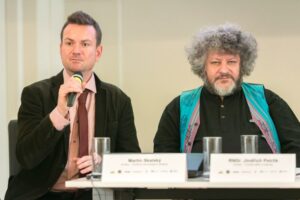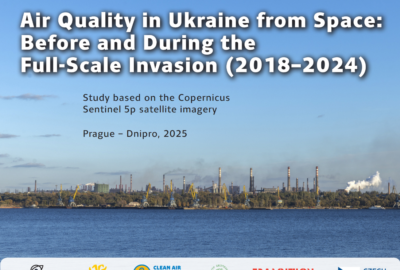Experts, politicians, and civil activists from Europe and former USSR countries are discussing ways to improve the air quality in the Czech Republic (1). Air pollution belongs to the most serious ecological problems of these days– it causes the premature death of four and half million people per year (2); the heavy industry is largely guilty of it. Today’s international conference wants to promote the exchange of people who push forward specific measures. Ostrava region can serve as a good example of success. Even though it still remains one of the most polluted places in the European Union, air pollution has been reduced by about half in comparison to the situation before 1989.
Lecturers from the Czech Republic, Poland, Croatia, Italy, Armenia, Ukraine, Kazakhstan, and Bosnia and Herzegovina came to the “Fighting Air Pollution in the Industrial Cities of Europe” conference in Ostrava (3). Under the auspices of Jarmila Uvírová, vice-governor of Moravian-Silesian Region and Kateřina Šebestová, deputy mayor of the city of Ostrava, non-governmental organizations Arnika (CZ) and Ecoaction (UA) organized the conference. The event is a collaboration with the University of Ostrava and is organized by the Global Greengrants Fund, the Moravian-Silesian Region and the city of Ostrava.
The connection among six participating countries is the activity of the international giant ArcelorMittal in their regions. Besides other things, participants will compare how the ecological and social responsibility of the steelworks differs from state to state. ArcelorMittal Ostrava will present their investments to environmental protection; afterwards, participants will have the opportunity to take a look at the modern technology in Operation Třinecké železárny (Třinec Iron and Steel Works).
Martin Skalský, chairman of the Arnika Association and head of the Citizens Support Center: “In many countries, citizens can not get access to true information about the current state of the environment. In many places, the level of pollution is not even credibly measured. The problem is also the enforceability of law, corruption, dysfunctional state administration, lack of interest from politicians, or huge influence of the industry representatives. Arnika wants to propose its experience during the last three decades in the Czech Republic to all civil activists in the countries where the situation is much more complicated. We support their campaigns for a better state of the environment because pollution has no limits. Providing solutions to global ecological problems is due to international cooperation.
MUDr. Radim Sram, DrSc., researcher at the Institute of Experimental Medicine, Czech Academy of Sciences: “During the last decade, the air pollutants in the Czech Republic have changed the bridge. In the northern part of the country, the main polluter used to be local furnaces. But due to big state investments in gas installations and technological modernization of power stations, the situation has considerably improved. In the Moravian-Silesian region, which has been on my radar for a long period, the situation is diverse. For example, in the district of Poruba and Karvina, the concentration of benzo (a) pyrene is decreasing, but in the district of Radvanice – Bártovice, the concentration is on the rise, which is probably the impact of the industrial activity. The overall level of air pollution in the Czech Republic has permanently increased, which has been shown to cause genetic damage. Unfortunately, it will have an impact on future generations as well.”
Jarmila Uvírová , vice-governor of the Moravian-Silesian Region said: “I am glad that this conference takes place right here in the Moravian-Silesian Region because it is an example of the region, which successfully copes with industrial history and related ecological burdens. Even though we still can’t say that all air pollution problems have been solved, I am happy to report that we are on the right track, which could serve as an example for other regions. Due to the investments in ecological technologies, industries, and local ideas– a boiler subsidy– made during the last fifteen years, the amount of emissions from solid pollutants decreased by about half. We continue to move forward; we want to replace all unsuitable boilers in households, support ecologization of industry and transport. We fight against bad habits, prejudice, and laziness; unfortunately, the landscape of our region and bad dispersion conditions are playing against us. After all, I’m still convinced that our efforts and determination will bring true change to the Moravian-Silesian Region, and it will no longer be called as polluted and dirty a city as it used to be. “
Mgr. Kateřina Šebestová, deputy mayor of the city of Ostrava, said: “Air quality in Ostrava has been significantly improving for a long period of time. Current emission from industrial resources has decreased to 5% of the state from 30 years ago. Despite all that, we still don’t breathe quality air. There is no simple solution to such a problem, as air pollution is caused by several factors. Speaking on behalf of the city, there is not much we can do against cross-border emissions from Poland and the “unfortunate” geomorphology of Ostrava Basin, but we progressively reduce the impact of other factors. I would give you right away by planting 550 thousand trees and bushes; originally “black” Ostrava was transformed to one of the greenest cities in the Czech Republic. We significantly ecologize the city transportation system; we contribute to the citizens of Ostrava for replacing boilers and grant them interest-free loans; we have increased the budget of child benefit intended for mountain trips up to 22 million crowns. We have multi-purpose road cleaning activities. We are working on tens of projects for green space expansions in the city or revitalization of existing ones, and we are building cycle ways and promoting alternative ways of transportation through many events during the year. We had a study elaborate on the potential launch of low-emission zones; we are now considering the possibility of introducing new transport measures, besides the smog measures. There are a number of different projects and measures to improve the air in Ostrava, and I believe the results will be known in a few years.”
doc. Ing. Petr Jančík, Ph.D., head of the Department of Environmental Protection, Faculty of Metallurgy and Materials Engineering, Technical University of Ostrava: “Besides the emissions from various sources, the weather itself has a significant impact on air pollution in our region. If we “remove” this influence, we can see that during the last years, there is an improvement trend of all significant pollutants at all monitoring stations, except the one in Radvanice – Bartovice. However, even there, we can still see positive development of suspended particles. It is mainly caused by dust off of investment in important technologies. If this positive trend is continued and benzo (a) pyrene pollution, it will be necessary to invest much more into technology, as well as its maintenance and operation. Impacts of potential actions will be shown by the air quality management system, created by the Air Tritia international project.
Prof. RNDr. Jindřich Petrlík, head of Arnika’s Toxics and Waste Program explained: “It’s the fact that, for the majority of the Czech Republic, the biggest source of pollution is either car transportation or local furnaces, where the coal has not yet been replaced by less problematic heating. The Ostrava Region is one of the exceptions where the source of pollution still results from industrial activities. People from similarly polluted places with huge metallurgical factories came to the conference in Ostrava. At the conference, we will present the importance of pollution registers and how they can be used as non-violent tools to push industries to reduce emissions of harmful substances. Of course, such measure does not solve the problem, but the information will be available. Unfortunately, such registers are still not widely used in many countries. However, multinational companies do make use of these registers; in some cases, they may even misuse it.”
The abovementioned benzo (a) pyrene is an aromatic organic substance, resulting from the combustion of organic material and a by-product of many industrial processes. Inhalation or direct contact with this toxic substance threatens the healthy development of unborn fetuses and increases the risk of cancer; in adulthood, it increases the occurrence of cardiovascular disease, diabetes, kidney failure and obesity.
Notes for editors:
(1) The conference Takes place from Monday to Wednesday at the Auditorium of the University of Ostrava. Everyone can join the conference for free after completing the registration form. For more information about the program, click here .
(2) Air pollution causes every year the death of more than four million people around the world for stroke, heart disease, lung cancer or chronic respiratory diseases. Approximately 91% of the world’s population lives in air pollution levels over the limits of the World Health Organization (WHO). Even though the problem affects both, developed as well as developing countries, in general, states with low- and middle-income are the most threatened ones – it mainly applies to the regions of the Western Pacific and south-eastern Asia. To find out more about the risks of low air quality, click on WHO page here .
(3) Should you be interested in an interview with a particular lecturer, we are more than happy to face-to-face or phone call including interpretation service. The complete list of participants and their profiles could be found here .
Translated by: Iveta Palúchová







